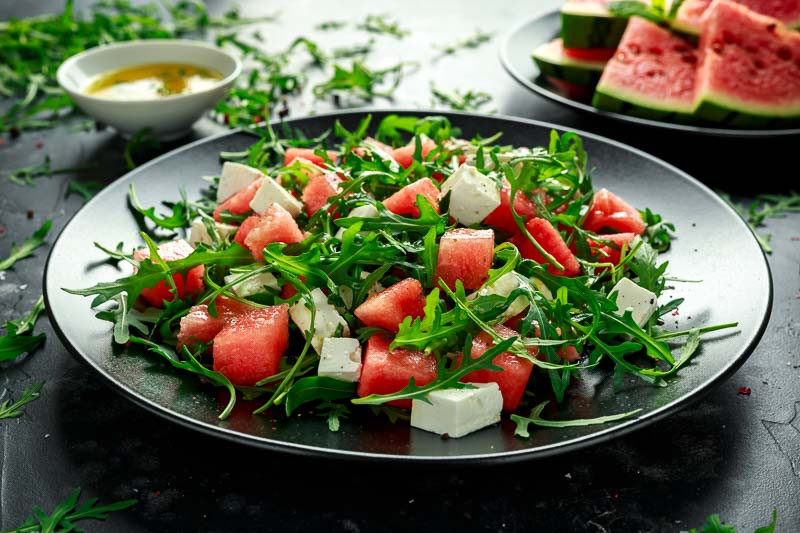Arugula, Rocket, Garden Rocket, Eruca, Ruchetta, Rucola, Rucoli, Rugula, Colewort, Roquette. Eruca sativa, Eruca vesicaria subsp. sativa, Brassica eruca
Arugula, also known as rocket, is an edible annual plant with a peppery, slightly bitter taste. It is a member of the Brassicaceae family, which includes cabbage, kale, and broccoli. Other common names include garden rocket (used in Britain, Australia, South Africa, Ireland, and New Zealand), eruca, ruchetta, rucola, rucoli, rugula, colewort, and roquette. E. vesicaria, which is widely popular as a salad vegetable, is a species of Eruca native to the Mediterranean region
Description: Arugula typically grows in a rosette shape and reaches a height of 12-24 inches (30-60 cm). Its small, white flowers with purple veins attract pollinators such as bees and butterflies.
Growth: A key fact about arugula is its ability to grow quickly, often ready for harvest in just 4-6 weeks after planting, making it a popular choice for home gardeners.
Hardiness: Arugula is a cool-season crop, hardy in USDA zones 2-11, and is able to tolerate light frost.
Uses: It can be used fresh in salads, as a pizza topping, or cooked in pasta dishes and sauces.
Health benefits: The plant boasts numerous health benefits, being rich in vitamins A, C, and K, as well as potassium, calcium, and folate. Its high antioxidant content is linked to reducing the risk of chronic diseases and promoting overall health.
Below are Arugula Nutrition Facts (per 100g of raw arugula):
Rich in vitamins and minerals: Arugula is an excellent source of vitamins A, C, and K, as well as minerals like calcium, potassium, and iron. These nutrients play vital roles in various bodily functions, including immune support, bone health, and blood clotting.
Antioxidant properties: Arugula is high in antioxidants, such as beta-carotene, vitamin C, and quercetin. These compounds help protect cells from damage caused by free radicals, potentially reducing the risk of chronic diseases like cancer and heart disease.
Heart health: The dietary nitrates in arugula may improve blood flow and lower blood pressure, promoting overall heart health.
Bone health: Arugula’s high vitamin K content is essential for bone health, as it helps with calcium absorption and blood clotting.
Weight management: With its low-calorie and high-fiber content, arugula can help you feel fuller for longer, potentially aiding in weight management.
Eye health: The vitamin A and beta-carotene in arugula are important for maintaining healthy vision and may protect against age-related eye diseases like macular degeneration.
Remember that individual nutritional needs and health benefits may vary, and it is essential to consult a healthcare professional before making significant changes to your diet.

Baby arugula refers to leaves that are harvested at a younger stage of growth, typically when the plant is around 2 to 4 inches (5-10 cm) tall. These young leaves have a more tender texture and milder, slightly sweet flavor compared to mature leaves, which tend to be larger and have a more robust, peppery taste.
Baby arugula can be used in the same ways as mature arugula, such as in salads, sandwiches, wraps, and pasta dishes. Because of its more delicate texture and flavor, baby arugula is particularly well-suited for salads or as a garnish. It is often found pre-washed and packaged in bags or containers at grocery stores, making it a convenient option for quick meal preparation.
Arugula is a versatile leafy green that can be used in various dishes. Here are some ways to incorporate it into your meals:
Salads: Arugula’s peppery flavor adds a unique touch to salads. Mix it with other greens or use it as the base for a salad, adding your favorite toppings like nuts, cheese, fruits, or vegetables.
Sandwiches and wraps: Add arugula to sandwiches, wraps, or paninis for extra flavor and a nutritional boost.
Pizzas: Arugula can be added to pizza either before or after baking. For a fresh taste, add it after the pizza is cooked or place it on top of the pizza before baking for a slightly wilted texture.
Pasta dishes: Toss arugula with pasta and your choices of sauce, such as a simple olive oil and garlic mix, pesto, or tomato sauce. You can also add it to pasta salads for extra flavor and nutrients.
Grain bowls: Add arugula to grain bowls featuring quinoa, rice, or farro, along with other veggies, proteins, and dressings.
Omelets and frittatas: Mix arugula into omelets or frittatas for a delicious and nutritious breakfast or brunch dish.
Soups: Stir arugula into soups right before serving to add a pop of color and a fresh, peppery flavor.
Smoothies: Blend arugula into your favorite green smoothie recipe for a nutrient-rich addition.
Pesto: Make a unique pesto by blending arugula with nuts, cheese, garlic, and olive oil. Use it as a spread, dip, or pasta sauce.
Sautéed or wilted: Sauté arugula with garlic and olive oil for a quick and tasty side dish. You can also add other ingredients, such as mushrooms, onions, or cherry tomatoes.
Remember to wash the arugula thoroughly before use, as dirt and grit can often be trapped in the leaves.

Growing arugula in your garden can provide several benefits:
Nutritious and healthy: Arugula is rich in vitamins A, C, and K, as well as minerals like calcium, potassium, and iron. It’s a healthy addition to your diet, providing various essential nutrients.
Fast-growing: Arugula grows quickly and is typically ready for harvest in just 4-6 weeks after planting. This makes it an excellent choice for gardeners who want a continuous supply of fresh greens.
Cool-season crop: Arugula is a cool-season crop, meaning it can be grown in the early spring and fall when temperatures are cooler. This allows you to extend your growing season and enjoy fresh greens beyond the summer months.
Easy to grow: Arugula is relatively low-maintenance, making it a great choice for beginner gardeners. It can be grown in containers or directly in the ground and doesn’t require much care beyond regular watering and occasional fertilizing.
Pest resistance: While deer and rabbits may be attracted to arugula, it’s generally less prone to pest issues compared to other leafy greens. Its strong, peppery flavor can act as a natural deterrent to some pests.
Attracts pollinators: The flowers produced by arugula plants attract bees and other beneficial insects, which can help improve pollination in your garden.
Culinary versatility: Arugula’s unique, peppery flavor can be used in various dishes, such as salads, sandwiches, pasta, and even as a pizza topping.
Space-efficient: Arugula plants don’t take up much space, making them an ideal choice for small gardens or container gardening.
Succession planting: Due to its fast growth and preference for cooler temperatures, arugula can be succession planted, allowing for multiple harvests throughout the season.
Environmentally friendly: Growing your own arugula can help reduce your carbon footprint by minimizing the need for transportation and packaging associated with store-bought produce.
By growing arugula in your garden, you can enjoy fresh, nutritious greens while gaining gardening experience and contributing to a more sustainable lifestyle.

Growing and caring for arugula is relatively easy, making it a great choice for gardeners of all experience levels. Here are some steps to help you grow and maintain healthy arugula plants:
Choose a location: Select a planting site with well-draining soil and at least 4-6 hours of sunlight per day. This plant can tolerate partial shade, which is especially beneficial in hotter climates to prevent bolting.
Prepare the soil: Amend the soil with compost or well-rotted manure to improve fertility and drainage. This plant prefers slightly acidic to neutral soil with a pH between 6.0 and 7.0.
Timing: Sow seeds in early spring, about 2-4 weeks before the last expected frost, or in late summer/early fall, about 4-6 weeks before the first expected frost. Arugula prefers cool temperatures and can tolerate light frost. Seeds will germinate in soil temperatures as low as 40°F (4°C).
Planting: Sow seeds directly in the ground or in containers, spacing them about 1 inch apart (2.5 cm) and 1/4 inch (0.6 cm) deep. If planting in rows, maintain a distance of 12-18 inches (30-45 cm) between rows.
Watering: Keep the soil consistently moist, especially during germination, which usually takes 5-7 days. Seedlings should emerge within this timeframe. Water regularly, but avoid over-watering, as it can lead to root rot and other problems.
Thinning: Once seedlings have developed their first set of true leaves, thin them to a spacing of 3-4 inches (7-10 cm) apart to ensure adequate airflow and prevent overcrowding.
Fertilizing: While arugula isn’t a heavy feeder, applying a balanced, slow-release fertilizer or side-dressing with compost can promote healthy growth. Avoid using excessive nitrogen, as it can result in overly tender leaves with reduced flavor.
Harvesting: Begin harvesting arugula leaves when they are about 2-4 inches long (5-10 cm), usually 4-6 weeks after planting. Pick outer leaves first, allowing the plant to continue growing for multiple harvests. Harvesting in the morning ensures the leaves are crisp and full of flavor.
Succession planting: To extend your harvest, plant new seeds every 2-3 weeks throughout the growing season. This will provide you with a continuous supply of fresh arugula.
Prevent bolting: Arugula has a tendency to bolt (produce flowers and seeds) when exposed to high temperatures or long daylight hours. To delay bolting, provide some shade during hot weather and consider planting heat-tolerant varieties.
By following these steps, you can enjoy a successful arugula harvest and incorporate this nutritious, flavorful leafy green into your meals.
Arugula is relatively low-maintenance and resistant to many pests and diseases, but it can still experience some issues. Here are some common pests and diseases that can affect arugula:
Aphids: These small, soft-bodied insects can infest the plant and suck sap from the leaves, leading to curled, distorted, or yellowing foliage. Aphids can be controlled with a strong spray of water or the application of insecticidal soap or neem oil.
Flea beetles: Flea beetles are tiny insects that jump when disturbed and feed on the leaves, creating small, round holes. Use floating row covers to protect young plants, and consider introducing beneficial insects like ladybugs to control flea beetle populations.
Cabbage loopers and caterpillars: These pests can chew large holes in the leaves. Handpick them from plants or use an organic pesticide containing Bacillus thuringiensis (Bt) to control infestations.
Slugs and Snails: These pests feed on the leaves, leaving behind irregular holes and slimy trails. Use organic slug control methods like copper tape, diatomaceous earth, or handpicking at night.
Downy mildew: This fungal disease causes yellowing leaves with white, powdery patches on the underside. Improve air circulation, avoid overhead watering, and remove affected leaves to prevent the spread of downy mildew.
Powdery mildew: Powdery mildew appears as a white, powdery substance on the surface of leaves. It can be controlled by increasing air circulation, reducing humidity, and applying a sulfur-based fungicide or a homemade baking soda solution.
Damping-off: This fungal disease affects seedlings, causing them to collapse and die. To prevent damping-off, use sterile potting mix, maintain proper moisture levels, and avoid overcrowding.
Black rot: This bacterial disease causes yellowing and wilting of leaves, followed by blackening of the veins. To prevent black rot, practice crop rotation, remove infected plants, and maintain proper plant spacing.
To minimize pest and disease issues, practice good garden hygiene, such as removing plant debris, rotating crops, and providing adequate spacing for air circulation. Promptly address any infestations or infections to keep your plants healthy and productive.
Is arugula good for you?
Arugula is good for you as it is a nutrient-dense leafy green vegetable. It is low in calories but high in vitamins A, C, and K, as well as minerals like calcium, potassium, and folate. It also contains antioxidants, which can help protect your body against oxidative stress and inflammation.
Can dogs eat arugula?
Dogs can eat arugula in moderation. It is a non-toxic food for dogs, and they can benefit from the same nutrients that make it healthy for humans. However, dogs have different nutritional needs than humans, so it’s essential not to rely solely on arugula or any single food as a primary source of nutrition. As always, it’s best to consult your veterinarian if you have any concerns about your dog’s diet.
Can you cook arugula?
You can cook arugula, though it is often enjoyed raw in salads and sandwiches. Cooking arugula can help soften its slightly bitter flavor and make it more palatable for some individuals. You can sauté, steam, or wilt it, and even add it to pasta dishes, soups, or stews. Note that cooking it can cause it to lose some of its nutritional value, particularly heat-sensitive vitamins.
| Hardiness |
2 - 11 |
|---|---|
| Climate Zones | 1, 1A, 1B, 2, 2A, 2B, 3, 3A, 3B, 4, 5, 6, 7, 8, 9, 10, 11, 12, 13, 14, 15, 16, 17, 18, 19, 20, 21, 22, 23, 24, A1, A2, A3, H1, H2 |
| Plant Type | Annuals, Herbs |
| Plant Family | Brassicaceae |
| Exposure | Full Sun, Partial Sun |
| Season of Interest |
Spring (Mid, Late) Summer (Early, Mid, Late) Fall |
| Height |
1' - 2' (30cm - 60cm) |
| Spread |
1' - 2' (30cm - 60cm) |
| Spacing |
3" - 4" (8cm - 10cm) |
| Maintenance | Average |
| Water Needs | Average |
| Soil Type | Chalk, Clay, Loam, Sand |
| Soil pH | Acid, Alkaline, Neutral |
| Soil Drainage | Moist but Well-Drained, Well-Drained |
| Attracts | Bees, Butterflies |
| Garden Uses | Beds And Borders, Patio And Containers |
| Garden Styles | Informal and Cottage |
DronG, V. Matthiesen, niindo, Peter Hermes Furian, Shutterstock
| Hardiness |
2 - 11 |
|---|---|
| Climate Zones | 1, 1A, 1B, 2, 2A, 2B, 3, 3A, 3B, 4, 5, 6, 7, 8, 9, 10, 11, 12, 13, 14, 15, 16, 17, 18, 19, 20, 21, 22, 23, 24, A1, A2, A3, H1, H2 |
| Plant Type | Annuals, Herbs |
| Plant Family | Brassicaceae |
| Exposure | Full Sun, Partial Sun |
| Season of Interest |
Spring (Mid, Late) Summer (Early, Mid, Late) Fall |
| Height |
1' - 2' (30cm - 60cm) |
| Spread |
1' - 2' (30cm - 60cm) |
| Spacing |
3" - 4" (8cm - 10cm) |
| Maintenance | Average |
| Water Needs | Average |
| Soil Type | Chalk, Clay, Loam, Sand |
| Soil pH | Acid, Alkaline, Neutral |
| Soil Drainage | Moist but Well-Drained, Well-Drained |
| Attracts | Bees, Butterflies |
| Garden Uses | Beds And Borders, Patio And Containers |
| Garden Styles | Informal and Cottage |
How many Eruca vesicaria (Arugula) do I need for my garden?
| Plant | Quantity | |
|---|---|---|
| Eruca vesicaria (Arugula) | N/A | Buy Plants |
Create a membership account to save your garden designs and to view them on any device.
Becoming a contributing member of Gardenia is easy and can be done in just a few minutes. If you provide us with your name, email address and the payment of a modest $25 annual membership fee, you will become a full member, enabling you to design and save up to 25 of your garden design ideas.
Join now and start creating your dream garden!
Create a membership account to save your garden designs and to view them on any device.
Becoming a contributing member of Gardenia is easy and can be done in just a few minutes. If you provide us with your name, email address and the payment of a modest $25 annual membership fee, you will become a full member, enabling you to design and save up to 25 of your garden design ideas.
Join now and start creating your dream garden!